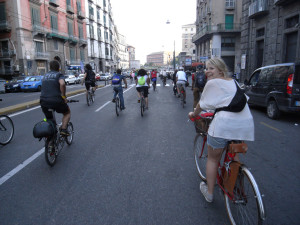Updated on Agosto 22, 2015
Omaggio al Mare, un momento da Franco (detto Diogenes)
« Lo iodo per combattere l’odio », bell’ anagramma trovato da Fanco, arstista filosofo inamorato del mare. Franco è nato e cresciuto a Nerano, e da piccolo, sempre gli è piaciuto, come a molti di noi, fare il bagno ed essere vicino alla grande distesa blu. Dopo aver studiato l’arte (e la vita) in Londra, è finalmente tornato nel suo paese, alle sue radici, ed ha aperto un bar sulla piazeta di Nerano che non è quasi cambiata dalla sua infanzia. In seguito, ha trasformato il suo bar in una vera mostra dedicata al mare, e qui, potete bere il caffè in mezzo a pensieri filosofici, pitture e sculture elaborate con diversi oggetti incontrati nell’aqua. Il mare è la sua musa, ed il suo momento preferito per scrivere è l’inverno. Quando non c’è nessuno e che puo tranquillamente ascoltarlo, osservare le sue numerose sfumature di colori, si immerge in totale comunione con la natura. Assaporando una granita al limone al suono di misica napoletana, ci ha precisato il senso della sua opera:
Un elemento principale guida la sua propria storia: Il mare. Il mare come origine e fine di tutto. Quello è pure l’idea prima nella sua opera. Ricordando i cicli naturali di molte specie che tornano sempre allo stesso posto della loro nascita, ci spiega che tutti, in un certo modo, ci sentiamo attrati dal mare perché, come dice, « circa il 72% del nostro corpo è costituito di liquidi (giusto come la Terra) quindi sente nostalgia della sua origine. Percio è importante essere sempre in contatto con la natura, non solo quando fa bel tempo ». Inoltre, Franco, attraverso la sua opera, rende omaggio al mare che cura il corpo come lo spirito, e ci fa sentire cosi bene, liberati, piu leggeri…« La salute nostra dipende del « dottor mare » … Il nuoto riempie il vuoto ». Da un certo punto di vista, Franco, raccogliendo oggetti per darl loro una nuova vitta, quindi togliendoli dall’acqua, cura il mare come il mare cura lui… una certa simbiosi tra di loro, insomma.
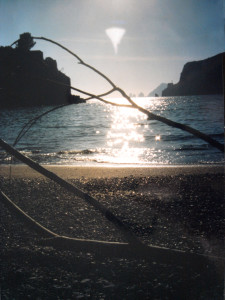
A questo punto, Franco evoca un po tristemente una certa malinconia del tempo passato. Oggi la gente ha dimenticato la sua origine acquatica, e si osserva una mancanza di rispetto verso il mare e l’ambiente. Ce lo dice la quantita incredibile di rifiuti che possiamo veder galleggiare cosi spesso, o che si arenano ogni giorno… come ad esempio nel Pacifico si è formato il cosi detto « sesto continente di plastica», che cresce ancora. L’opera di Franco non consiste unicamente nella descrizione del suo amore per il mare che l’ha visto crescere, ma anche nella denuncia della sua situazione attuale. Ci raconta come l’ha visto degradarsi anno dopo anno: « Prima, nella zona, c’era la foca monaco. I pescatori raccontano che arrivavano a terra, mangiavano chicchi d’uva e poi, tornavano in mare. Evoca anche l’ « orecchio di Dioniso » e l’ippocampo, che vedeva da piccolo, e che non si vedono piu. L’azione del uomo a fatto del mare che ha conoscuito un altro mare: « Ora con i fertilizzanti che vanno al mare, non è piu lo stesso, dopo il bagno, ho bisogno di una doccia »
Dal suo messagio, ci rimane questo : Recuperiamo i valori di prima, da quello dipende il nostro futuro. « La terra non ha bisogno di noi, noi invece si. Siamo arrivati al putno in qui non basta piu non sporcarla, ma bisogna curarla ».
Il NUOTO RIEMPE IL VUOTO
« Senza la guerra
Paradiso è la Terra
Del Mare lo iodio
Per sconfigere l’odio.
Il nuoto riempie il vuoto.
Nuotare come volare
Ma il naufragar
Non m’ è dolce
In questo mar…
Di naufraghi extra comunitari »
Updated on Novembre 20, 2020
Accatate ‘a bricicheeeeetta !
Era i 6, 7 e 8 di giugno, e ce l’abbiamo gridato tutti nelle vie napoletane. Per 3 sere, le strade erano nostre. A volta manifestando in un bello concerto di campanelli (si si!), a volta scivolando in silenzio sotto lo sguardo geloso dei pedoni (si si si!). Però erano NOSTRE. Per una volta.
Perché? Perché pensiamo che cambiare le abbitudine, ok, è difficile PERO’ che può migliorare molte cose, e che se più gente andava in bicicletta:
-
Forse… ci sarebbero meno d’inutili macchine meta vuote, quindi meno traffico, quindi meno inquinamento atmosferico?
-
Forse … diminuerebbe il nostro consumo globale di petrolio? (non c’è bisogno di ricordarvi che le risorse naturali del nostro piccolo pianeta non sono inesauribili, e che ne approfittiamo già di un modo critico no?)
-
Forse … si senterebbe più independente, e qualche volta anche piu veloce?
-
Forse … sarebbe più economico per lei?
-
Forse …. avrebbe pulmoni più grandi, più belli, più potenti, e soppratutto delle gambe meravigliose?
-
Forse … sentirebbe il vento nel suo capello (vi assicuro, è belliiiissimo) … e si sentirebbe più felice?
-
Forse … le città sarebbero pensate in un modo piu conviviale?

© http://www.velogirls.com
Pensateci e … accatate ‘a bricicheeeeetta !
Bike and peace.
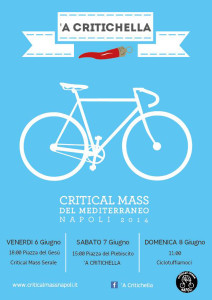 PS : Per ragguingere la squadra in Napoli > Critical Mass Napoli
PS : Per ragguingere la squadra in Napoli > Critical Mass Napoli
Updated on Novembre 20, 2020
Accatate ‘a bricicheeeeetta !
It was the 6th, 7th and 8th of june, and we all screamed it trough the napolitan streets. For 3 evenings, the roads where ours. Sometimes protesting in a nice bike bell concert (yes yes!), sometimes sliding silently under the jealous eyes of many pedestrians (yes yes yes!). But they where OURS. For once.
Why? Because we think that changing our everyday habits, well, it’s hard, BUT it can change many things for the better, and if more people were riding bikes:
- Maybe … there would be less useless almost empty cars? And much less traffic? And much less pollution?
- Maybe … it would reduce our global consumption of petrol? (is it necesarry to remind you that the natural resources of our little planet are not inexhaustible – and that they are already critically drained?)
- Maybe … we would feel more independent and sometimes even faster?
- Maybe … it would be more economical?
- Maybe … we would have bigger, nicer, more powerful lungs, and above all, wonderful legs?
- Maybe … we would feel the wind in our hair (I assure you, it’s soooo good)… and it would make us feel happier?
- Maybe … cities would be designed in a more convivial way ?

© http://www.velogirls.com
Just think about it, and accatate ‘a bricicheeeeetta !
Bike and peace.
 To join the crew in Napoli, get in touch with Critical Mass Napoli
To join the crew in Napoli, get in touch with Critical Mass Napoli
Updated on Novembre 20, 2020
Visiting the ruins of Marina di Crapolla
Last Thursday 9 of May, the volunteers of Project MARE visited the ruins of Marina di Crapolla with the help of the guide Stefano Ruocco, who is a member of the ArcheoClub of Massa Lubrense. The tour started on the beach and continued up along the old path of 650 steps.
2000 years ago Marina di Crapolla was a very important point for fishermen, trade, stocking food and supplies, and to collect water. Today the sea level is 2m higher than back then, when the beach was larger. It was used by the two roman villas on the islands of Le Galli and Isca near the marina. It functioned like a second harbor of Sorrento, because it was easier to carry the food over land than to go all the way around the Sorrento Peninsula by boat.

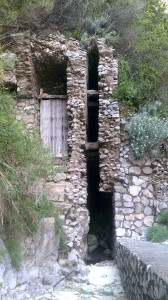
One of the amazing things of this Marina is a roman structure made to collect the water from a near waterfall. This structure remains unique to this day as so far no-one has found anything similar. This structure allowed the sea to create the beach because it rerouted the water coming from the mountain. At the end of the structure there was a pool where the water was collected to be used by the people.
Some other really important roman structures in the marina are the remains of 5 cisterns where drinkable water was collected to be used for washing, gardening etc. Today only 3 of the cisterns remain because the other two were destroyed by falling rocks.
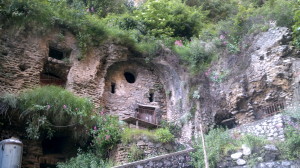
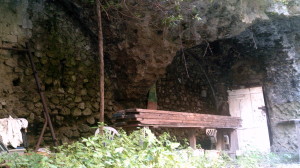
Talking from an architectural point of view we can distinguish two different kinds of walls: the “opus reticulatum” (up) with form of rhombuses and made of volcanic rock, called tufo, which comes from the islands in the gulf of Napoli and not from the Vesuvio; the other kind of wall is the “opus incertum” (down) with a random distribution of the rocks, non-volcanic ones in this case.
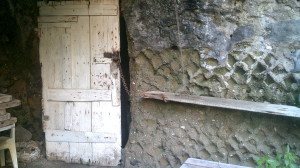
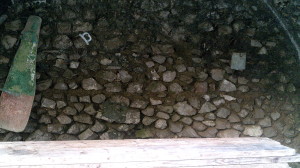
On our way up, we could see the remains of another ancient roman structure on the right side of the marina, which used to be a 4-storey building in the mountain. There was a store for materials, food and jewelry. Today we can only see the caves where boats were attached and the top of the building.
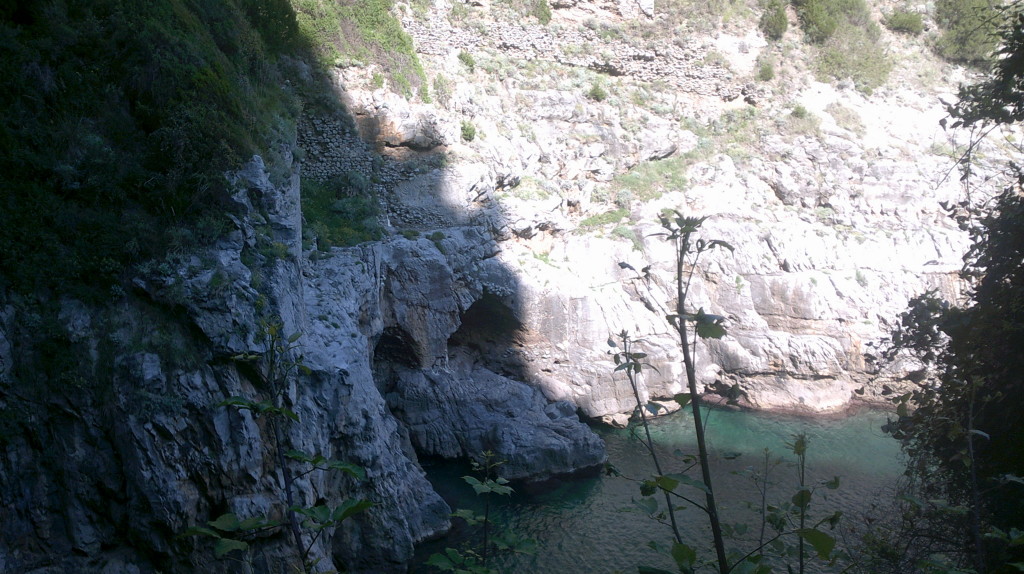
Continuing the way up we jump 1000 years ahead in time and we can find an ancient church. The church belonged to an abbey which hosted 30 benedictinean monks, who abandoned the abbey around 1130 cause of problems with piracy and moved to S. Agata. This church is called “San Pietro a Crapolla” and is dedicated to San Pietro, because it’s said that San Pietro (St. Peter) passed by this abbey during his trip from Palestine to Roma to found the Christian Church.
Originally the entrance of the church was placed where today we can find a little chapel with a Madonna. In the front of the entrance there was a really beautiful garden with a cistern in the middle. The church had 3 parts, a central one, and two corridors on the sides with paintings on the wall. Today we can only see small remains of some columns which were taken from roman villas of the islands around.
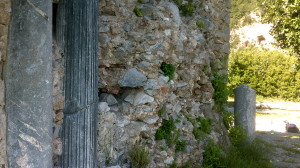
From the garden of the abbey we could see one of the ancient roman villas, placed on the island of Isca. A typical marine roman villa had 3 parts: the Domum (where the people lived), a garden, and the harbor. In the garden they already had lemons, but as they didn’t know their nutritious properties they only used them as ornamental plants.
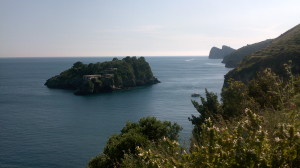
Finally we talked about the tower that can be seen from the stairs when leaving Crapolla and the abbey. This tower is part of another 300 vigilance towers which are spread along all the coast of Southern Italy. They were built around 1570-80 in response to a Turkish invasion that happened ten years before. These towers were supposed to alert the population against pirates coming from the sea. Each tower had in its sight two neighbour towers to relay the alert to the entire region.
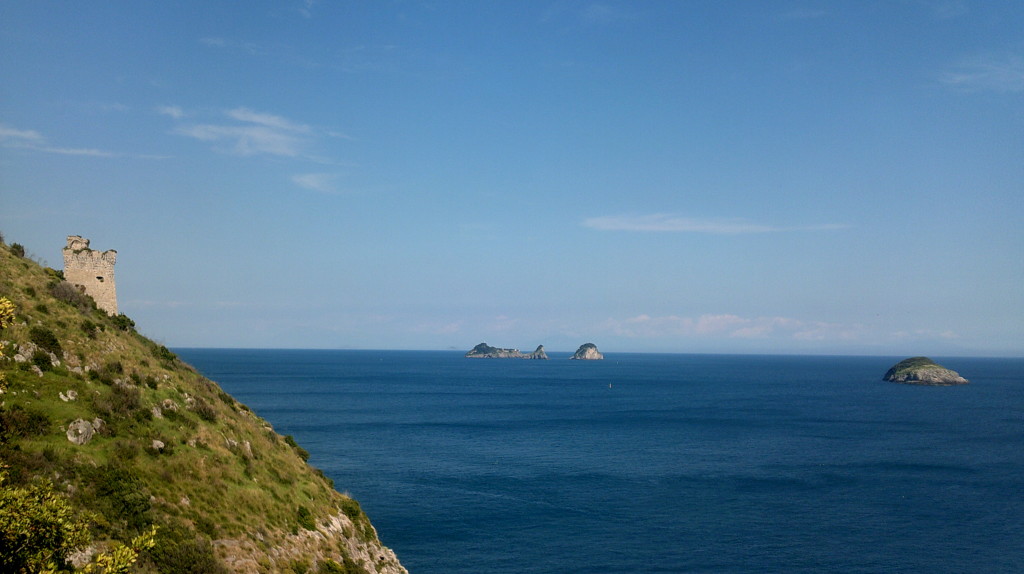
We hope that you found this article about Crapolla interesting, we recommend you to visit it following the path that starts from Torca.
Thanks to Stefano Ruocco for this beatiful guide visit!
Ce verrim’!
Updated on Novembre 20, 2020
Visitando le rovine di Marina di Crapolla
Il 9 di maggio scorso noi volontari del progetto MARE abbiamo visitato le rovine di Marina di Crapolla, con la nostra guida Stefano Ruocco, che lavora all’ArcheoClub di Massa Lubrense. Siamo partiti dalla spiagga e poi siamo saliti per la vecchia scalinata con i suoi 650 scalini.
2000 anni fa Marina di Crapolla era un luogo molto importante adibito allo stoccaggio di cibo, materiali vari e per la disponibilità d’acqua potabile. Oggi il livello del mare è cresciuto di 2m e di conseguenza la spiagga si è rimpicciolita. Le ville romane construite sulle l’arcipelago di Li Galli ed a Isca si servivano di Marina di Crapolla come una succursale del porto di Sorrento. La difficoltà di circumnavigare la penisola rendeva necessario il trasporto delle merci via terra da e per Sorrento.


Una delle cose più interessanti di questa marina è la condotta costruita ai tempi dei romani per raccogliere l’acqua dolce da una cascata li vicino. Si tratta di una costruzione unica nel suo genere perché non ne sono state trovate altre simili. Questa struttura ha consentito al mare di creare la spiaggia, perche impedisce all’acqua proveniente della montagna di riversarsi nel mare; la stessa è invece convogliata in una piscina artificiale.
La costruzione comprende anche cinque cisterne usate per stoccare l’acqua del fiume che serviva per usi domestici e agricoli. Oggi ne sono rimaste solo tre, le altre essendo state distrutte da dei crolli.


Dal punto di vista architettonico si distingono due tipi di muri: il “opus reticulatum” (sopra) di struttura romboidale costruita in tufo proveniente dall’Arcipelago Campano e non dal Vesuvio; l’altro tipo di muro è chiamato “opus incertum” (sotto) e presenta una distribuzione aleatoria delle pietre, in questo caso non vulcaniche.


Più in alto si vedono altri resti romani sul lato destro della marina. Si tratta di un edificio di quattro piani sul fianco della montagna che serviva da magazzino per cibo e merci. Oggi ne restano solo le grotte dove attraccavano le navi e la parte alta dell’edificio.

Salendo per la scalinata si fa un salto di mille anni nel tempo e troviamo una chiesa antica che apparteneva a un’abbazia benedettina con una trentina di monaci i quali abbandonarono il posto nel 1130 a causa della pirateria, trasferendosi a S.Agata. Questa chiesa, dedicata a San Pietro, si chiama “San Pietro a Crapolla”. Si dice che il santo sia passato per l’abbazia nel suo viaggio dalla Palestina a Roma per fondare la Chiesa Cattolica.
Originariamente l’entrata era situata dove oggi si trova la cappelletta della Madonna. Di fronte all’entrata della chiesa c’era un giardino ancor’oggi riconoscibile sotto le sterpaglie. La chiesa aveva tre navate: una centrale e due laterali affrescate. Attualmente ne restano alcune colonne provenienti dalle ville del vicino archipelago.

Dal giardino dell’abbazia si vede una delle antiche ville romane, costruita sull’isola d’Isca. Una villa romana tipica era costituita da tre parti: il Domus (la parte adibita ad abitazione), il giardino ed il porto. A quel tempo si coltivavano già i limoni, ma le loro proprietà nutritive erano ancora sconociute, ed erano considerate piante ornamentali.

Infine abbiamo la torre, visibile dalla scalinata sovrastante l’abbazia, facente parte di una serie di torri di avvistamento situate lungo la costa del Sud Italia. Queste torri furono costruite tra il 1570 e il 1580 circa in seguito alle invasioni turche degli anni precedenti e servivano ad allertare la popolazione. Ogni torre comunicava con le torri adiacenti per trasmettere rapidamente l’allerta a tutta la costa.

Speriamo che abbiate trovato questo articolo su Crapolla interessante e vi consigliamo la visite seguendo il sentiero che parte da Torca.
Grazie mille alla nostra guida Stefano Ruocco per questa bella visite guidate!
Ce verimm’!


